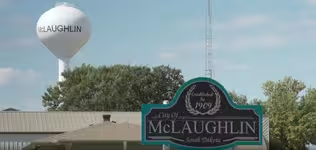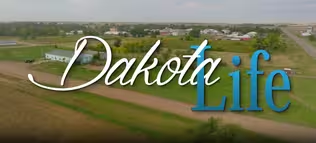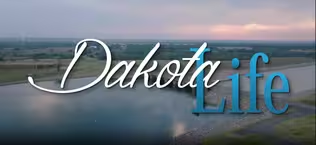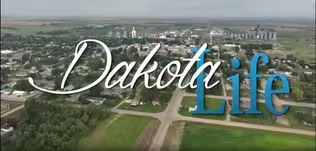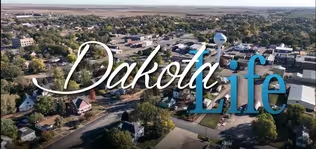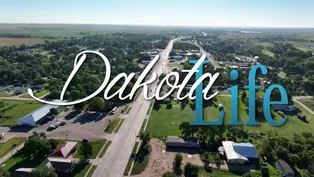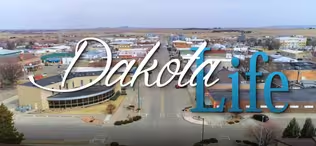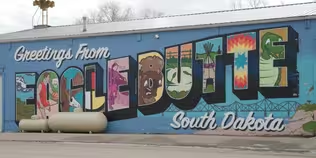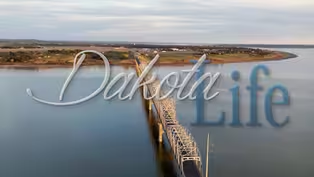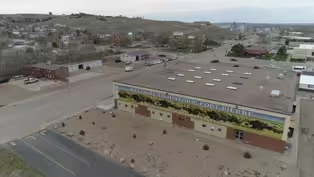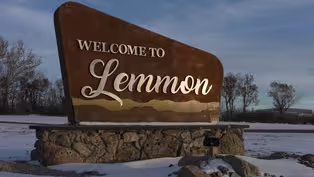Dakota Life
Greetings from Murdo
Season 24 Episode 5 | 27m 50sVideo has Closed Captions
Greetings from Murdo
SDPB tells the story of the first Meghan Newsam Community Celebration and why it was so important to the town of Murdo. We visit the Fort Pierre National Grassland south of Fort Pierre, visit the Pioneer Auto Show and Museum, which has revved up the interest of car lovers everywhere and learn about the particular emphasis on hunter education for the Murdo area youngsters.
Problems playing video? | Closed Captioning Feedback
Problems playing video? | Closed Captioning Feedback
Dakota Life is a local public television program presented by SDPB
Support Dakota Life with a gift to the Friends of Public Broadcasting
Dakota Life
Greetings from Murdo
Season 24 Episode 5 | 27m 50sVideo has Closed Captions
SDPB tells the story of the first Meghan Newsam Community Celebration and why it was so important to the town of Murdo. We visit the Fort Pierre National Grassland south of Fort Pierre, visit the Pioneer Auto Show and Museum, which has revved up the interest of car lovers everywhere and learn about the particular emphasis on hunter education for the Murdo area youngsters.
Problems playing video? | Closed Captioning Feedback
How to Watch Dakota Life
Dakota Life is available to stream on pbs.org and the free PBS App, available on iPhone, Apple TV, Android TV, Android smartphones, Amazon Fire TV, Amazon Fire Tablet, Roku, Samsung Smart TV, and Vizio.
Providing Support for PBS.org
Learn Moreabout PBS online sponsorshipMore from This Collection
Dakota Life stories from towns in central South Dakota
Video has Closed Captions
In the heart of the Standing Rock Indian Reservation, we discover McLaughlin. (29m 29s)
Video has Closed Captions
We travel to Burke and introduce you to a writer, an artist, and the twins of Franklin Street. (29m 50s)
Video has Closed Captions
Timber Lake celebrates its heritage in July with the Days of 1910 activities. (29m 41s)
Video has Closed Captions
Uplifting culture of the Dakota Oyate on the Crow Creek Reservation. (29m 17s)
Video has Closed Captions
Onida is home to a ranching family, a salmon fisherman, and a memorabilia collection. (27m 18s)
Video has Closed Captions
Dakota Life travels to the community of Mission. (29m 34s)
Video has Closed Captions
Winner has great baseball, theatre, and local authors and is a sportsperson's paradise. (27m 25s)
Video has Closed Captions
Dakota Life visits the community of Eagle Butte (26m 58s)
Video has Closed Captions
Fort Pierre is our host community this month for Dakota Life. (28m 36s)
Providing Support for PBS.org
Learn Moreabout PBS online sponsorship- [Announcer] This is a production of South Dakota Public Broadcasting.
(light music) - At the western edge of the Central Time Zone on the eastern outskirts of the Badlands, you'll find the town of Murdo.
It's surrounded by range land with I-90 cutting an 80 mile an hour line on its southern edge to and from that Mountain Zone, just a few miles away.
Some towns gradually dissipate at the margins, others end abruptly.
Well, Murdo is one of the latter.
From the center of town, you can look in any direction and see exactly where it ends.
The original, unofficial town site was a quarter mile east.
You see, when the railroads were designating town sites, word often leaked out in advance.
Entrepreneurs heard about it, and built their storefronts in anticipation of that official lot sale in July of 1906.
After the sale, Murdo became a town on wheels, and the buildings were moved to their new locations.
The town newspaper then and now is the Murdo Coyote.
It announced the coming of the new soon-to-be metropolis of Lyman County.
Now, if that doesn't sound just right, you see a decade later, voters decided to divide Lyman County roughly in half, and Murdo became the county seat of Jones County.
Today, Jones County is the least populous county in all of South Dakota.
Just over 900 people live here, and over half of those in Murdo.
You know, and that may be a metropolis by local standards.
Murdo was platted as a typical tee town, with Main Street perpendicular to the railroad tracks with grain elevators and lumberyards on one side of the tracks to keep the heavy equipment out of the business district.
You get that sense even today when you drive down Railroad Street.
Well not long after the town was established, a raging fire in the middle of winter burned a majority of the downtown business district.
Murdo rebuilt to launch its greatest period of expansion.
Welcome to Dakota Life and greetings from Murdo.
(bright music) - [Announcer] This program is made possible with your support and with corporate support from the Murdo Chamber of Commerce, and the thriving Murdo business community, and by Golden West Telecommunications Cooperative.
We're everywhere people connect, including Murdo.
More at goldenwest.com.
- Murdo is named after legendary cattleman Murdo MacKenzie.
He ran the Scots-based Matador Land and Cattle Company for many years.
They were on the lookout for additional grazing land when Matador's Texas landholdings became overgrazed.
MacKenzie negotiated leases for a half a million acres of land on the Cheyenne River Sioux Reservation.
They moved cattle from Texas to South Dakota by rail and overland.
That included a two and a half month drive in 1893.
2,000 steers over land from Texas to a ranch near Rapid City.
Then, moving the cattle from their northern pastures to the stockyards by ferry, across the Missouri River at rail heads at Evarts and LeBeau.
the Milwaukee Railroad actually created a cattle trail for outfits like the Matador.
It was a strip of land leased six miles wide and stretched from just outside the Black Hills to the ferry crossings, with watering holes every 12 miles.
The cattle towns like Evarts and LeBeau disappeared when the railroads chose other points to cross the Missouri.
But LeBeau's fate may have been sealed when MacKenzie's son, Dode, was shot and killed in a saloon there in 1909.
After the alleged shooter was acquitted, LeBeau mysteriously burned to the ground.
During his career, MacKenzie successfully negotiated better prices for producers, and he made frequent trips to Washington, establishing a lasting friendship with President Theodore Roosevelt.
Roosevelt even visited MacKenzie later in life at his ranch in Brazil.
MacKenzie was recognized for his efforts on behalf of producers when he was elected the first President of the American Stock Growers Association.
Though they often sparred over the prices for transporting stock, the Milwaukee Road named Murdo in honor of MacKenzie.
And though MacKenzie never lived in South Dakota, he won important concessions for cattle producers, as they transitioned away from the open range era, and recovered from what they call the Big Die Up in 1886.
That was a series of blizzards and sub-zero temperatures that killed millions of cattle on the Northern range.
In 1979, he was inducted into the South Dakota Hall of Fame.
Coming up, we'll check in with the local sportsman's club, explore the nearby Fort Pierre National Grasslands, and see one of the ways this community comes together with the Meghan Newsam Community Celebration.
But first, we're going to take a tour of some classic rides here at Murdo's World Famous Pioneer Auto Show.
(horn honking) - Well, it's just a kind of a hobby that got out of hand.
We've been here 67 years.
My grandfather started this place in 1954.
It kind of started as an accident.
He used to be a John Deere and Chevy dealer, and he'd get some oddball cars traded in at the Chevy dealership, and he started setting them outside.
Now we got 42 buildings, 250 cars, 60 tractors, a whole whole village full of stuff.
Collections upon collections.
Guns, toys, dishes, jukeboxes.
I mean tractors, motorcycles, bikes, car, I mean signs, amazing sign collections.
- [Larry] Since 1954, the Pioneer Auto Show Museum has been a staple of Murdo, now labeled as a world famous establishment.
The Geisler family is still as thankful as ever about the community support.
- Well, we love the people in Murdo.
They've been very supportive.
My dad was a Chevy, John Deere dealer.
I was a Ford dealer.
These are friends and customers, but here we are.
Here we are almost almost 70 years later.
That has been very good to us.
Since we opened, there was 27 different car museum and Rapid City has four or five of them, and Sioux Falls had some, (indistinct) had some, Custer had some, other up in the Northeast.
Now we're down to just us and Bill Napoli has, and his wife, have a museum and sales in Rapid.
There's actually, it's not a good, it's everyone went broke, and we, God has been so good to us.
We kept adding on, and we're still here.
- [Larry] Pioneer Auto Show was started by Dick Geisler.
His son, Dave, took it over.
Now today, Dave's daughter, Vivian, and son, David, are keeping the dream alive.
- We have a lot of people that meet in Murdo.
Like if somebody needs to, I've had people trade in parents in Murdo.
Rapid City to Sioux Falls or further, between Denver and Aberdeen, they meet and Murdo.
So between 83 and I-90, they always seem to stop and meet in Murdo, and do an exchange, or they just meet in Murdo and have a meal.
(Vivian laughs) Yeah, so it's pretty interesting.
- I mean, it's harder to get people to stop, get off the interstate.
People are going 80 miles an hour, and everybody's got on their schedule and got an agenda.
So it's getting harder to get them to stop, but we're still here.
We're buying and selling stuff, and trading stuff.
That kind of keeps us going.
Ticket sales are, you know, everybody just kind of decides what they want to spend their money on when they go on vacation, so hopefully we're on the list.
- [Larry] In 2016, the History Channel show American Pickers featured the Geisler's passion.
- They came to us and they had, they spent about $70,000 the first time, less the second time, and the pickers have helped us a lot.
Brought a lot of people in.
And here we are at the crossroads of America.
Why do we say that?
From Mexico to Canada, from Seattle to Boston, right here in the middle.
And here we are helping people.
- [Larry] The Pioneer Auto Show Museum has become a symbol known locally, regionally, and nationally, but it's the Geisler's warm and respectful way of doing things that has kept the big show going for nearly seven decades.
- Family businesses.
Small family business really thrive on hospitality and making our visitors feel welcomed.
That's one of our main goals.
That's our training.
(Vivian laughs) - We live on memories, and we love so much of the, if you look around, there's a complete variety everywhere.
- [Larry] Pioneer Auto may be the first thing that comes to mind when you think of Murdo, but there's much more to see.
About 15 miles up the road, you may notice the inconspicuous Immanuel Lutheran Church.
It's nestled among the rolling hills and wandering buffalo.
A community of Norwegian immigrants settled in and around these hills, even before Murdo was established.
They formed the Immanuel Lutheran congregation, and eventually raised enough money to build this church in 1924.
Architecturally, the church is relatively austere.
Like many Plains Lutheran churches, it never had running water.
For years, services were held in the afternoons, because Immanuel shared a pastor with a congregation in Midland.
People have been working together to preserve this church since the 1980s, and now services are held monthly in the summer.
This area is known for fine hunting opportunities, and there's a keen interest in the shooting sports, and archery has been part of life here for generations.
When we asked, "Where do people gather?"
many answered at the Murdo Sportsman's Club.
It's the home of all kinds of civic and social activities, including competitive shooting events, inside and outside the clubhouse.
There's hunter education for area youngsters.
And it's just one of the ways the community tries to engage kids in positive activities and foster good memories of growing up in Murdo.
For a lot of people living in and around Murdo, a narrow metal building on the north side of town is the social and civic hub of the community.
It's a lot longer than it was when the first dirt floored building went up in 1949.
There's heat now and air conditioning, and it gets a lot of use as an indoor gun and archery range.
- Yes, we do have league nights, whether it be archery or pistol.
They don't get run probably as often as they used to, because we're focused on the kids so much, which we're really thrilled about, because it's the life of the club.
- [Larry] In fact, a very high percentage of Murdo kids between eight and 18 are signed up.
- I'm so proud of the kids, they're like, I think every one of us as instructors call 'em our kids, our family.
We are a big family.
In Jones County, we've had as many as 54 youth out of the school system for in the 4-H program.
And considering we are the smallest county in the state, and the least populated.
- [Larry] Two things are really important about the 4-H youth gun and archery program.
- Safety, youth development.
And if you put those together, the skill development just follows along, and we've had some great success with a lot of our programs, just because of that.
When the kids enjoy it, and know that you care about what they're doing, it's pretty amazing.
- [Larry] Parents sometimes join the certified instructors at the range.
For some it's about learning to hunt safely.
Others focus on the skill of punching a hole in the exact center of a paper target from pretty far away.
- It's like anything that you do.
Do you like it because it's a lifelong sport, or do you like it because you like the ribbons and the trophies?
And you have every end of the spectrum and that's okay.
- [Larry] Some of the kids learning the shooting sports also get into archery, very into archery.
- It's pretty meticulous.
It's a mental game.
It's all about the very, very little details and paying attention to that.
- You can put five shots in each bowl.
- [Larry] Interacting with adults is a baked in part of the program.
Those interactions also yield some life skills.
- You're in 4-H, you come in and you get to learn.
You're doing part Robert's Rules parliamentarian procedure, so you're running, you know, figuring out how to run a meeting, how to communicate with other people, and work well within a group, and I think those are a great set of life skills that every kid needs in life, so especially nowadays being able to sit here and have a face-to-face conversation, and not get all riled up and nervous, even though I still have been getting a little nervous, but it definitely helps.
- [Larry] Growing that confidence will help grow leadership skills, and that'll help the kids in whatever field they choose to go into, including maybe politics.
- Yes, I was South Dakota's first Game Fish and Park Youth Ambassador.
And that happened when I went up to the meeting with the eight commissioners, and I petitioned them for the youth pheasant hunt season.
And they asked me if I would become their first youth ambassador to help get more youth involved.
- [Larry] So how'd that work out?
- I got the five days youth pheasant hunting season to be nine days, so much more time to go out and do what I love the best.
- [Larry] They learn how to deal with the small things in life, and pretty soon they get an idea of how to handle the bigger things.
- I think we have great kids that can adapt when they go out on the range.
Just like these guys working down here, something is not working right.
They figure out what it is that it, you know, figure out the problem and how to fix it.
- [Larry] Figure out the problem and fix it, a pretty good thing to learn early.
Shooting, archery, and other 4-H activities are just a few of the things keeping Murdo kids busy outside of school.
A few years back, media mogul Ted Turner came to town and pledged ongoing grant money for youth projects.
- He said, "I want our youths to be future leaders.
"I want them to be empowered "to make decisions that will better their community."
- [Larry] That was in 2004.
Since then, program leaders have been able to pull in even more grant money for youth-oriented community improvement projects.
- We were able to spend it on a lot of different things, so we put a new playground out to the park a couple different times.
We've helped renovate base, or the basketball, outdoor basketball court.
The Turner Youth Foundation is, has met with the city, because the youth would like to improve the shooting range out north of town.
- [Larry] What's unique about the Turner Foundation approach in Murdo is that young people are included in all of the decision-making.
If they have an idea, then they have to make a plan, and pitch it to the city council.
It's a strong civics lesson, but there's more to it than that.
- So if anything, I think it's giving them confidence to walk into a leadership position and confront, you know, your leaders in your society, and in your town, and feel confident about it.
Now I've been in this long enough that I see these kids coming back to the community, and they bring their families, and I hear them say, you know, "I helped renovate this.
"I helped put those trees in at the park.
"I helped with the playground equipment."
I mean, so it has made a mark on them.
- [Larry] When it comes to keeping a small town thriving, if there are opportunities, there's hope.
- There are even more activities for young people around the area.
For instance, the Murdo City Park has a small lake.
It's stocked with fish, so young anglers can practice their skills.
And there's the Jones County Invitational Tournament.
For over 50 years, West River basketball teams compete for top honors here at the Jerald Applebee Court.
We've got a story from a few years back for you on the invitational.
It's at sdpb.org/dakotalife.
There are so many places around our state that we're more apt to drive by then take the exit.
One of those is the Fort Pierre National Grassland.
Part of it is here in Jones County, and if you've ever traveled from I-90 north to Pierre, you've seen the signs and you've driven through, but a national grassland?
Well it's part Dust Bowl-era mitigation, it's part conservation with a mixed grass prairie, and it serves multiple uses, from grazing to wildlife and fishing habitat.
- [Dan] National grasslands, I would argue, are the biggest ecological restoration success story in the history of humankind.
- That's how Dan Svingen, District Ranger and Capital City Coordinator for the US Forest Service, feels about the National Grassland, a program born out of the Dust Bowl and Depression era of the 1930s.
- In response to that hardship, the federal government launched the land utilization projects, where they bought back some of the sub-marginal land, and then they went about trying to restore that, and trying to get it with grass again, so that the Dust Bowl would abate, so that the dust would stop blowing.
- [Larry] The soil conservation service, today's NRCS, was launched, and large tracts of land were set aside in 13 states.
In South Dakota, they include Buffalo Gap, Grand River, and the Fort Pierre National Grassland.
And from the beginning, the goal has been mixed use of the restored prairie.
- So the three big ones locally are conservation, livestock grazing, and recreation.
Conservation, we support one of the healthiest greater prairie chicken populations left.
We're also real important for a lot of these grassland birds that are disappearing range-wide.
In terms of livestock grazing, our neighbors pasture their privately owned cattle under permit on the national grassland, and that's just a godsend.
That is our primary management tool to manipulate the health of the grass.
And then for recreation, we get lots of visitors coming in for hunting.
We get lots of visitors coming in for birdwatching, camping, and fishing.
- [Larry] So the National Grassland encourages you to turn off the highway, and enjoy what the land has to offer.
But if you already live there and raise livestock, it's not only your family business, but you're also a key part of the prairie ecosystem.
- I'd reminisce back when, say, Lewis and Clark was around here and it had all the buffalo roaming around.
You had a three-inch rain, and the buffalo were moving through here in the millions, and the ground would look like a plowed up side field.
Well, that was restoring the grass seeds back into the ground, and utilizing, getting that stimulating, breaking up the dead grasses, and putting in the seed.
The livestock now are in the process of replacing the buffalo in that deal, so their hooving action breaks up the thatch and replants the native seeds back in the ground, and brings back the native plants.
- Noel Hendrickson was not only born here.
He has a grassland grazing permit for his livestock, and he represents his fellow ranchers on the board of the local grazing district, which is a group that works with the Forest Service to maintain the land and find agreement when changes are needed.
- Well, I think the pasture rotation system has changed a lot through the years.
We used to be season long in some of the pastures, and now we're doing a, like a three or four pasture rotation to give the grasses a rest.
- [Larry] Granted, the groups don't always see eye to eye, but they are working together, along with researchers at many area universities, to study any new threats that come to the grassland.
- A real big project that we're just getting started on is these invasive species.
So we're dominated by this mixed grass prairie, but the exotic grasses, especially smooth brome and Kentucky bluegrass, are a huge threat.
- [Larry] That issue is one that all the groups agree needs to be addressed, but it's more than work.
They have a real passion for this land.
- I've been lucky to work throughout the American west, and work in several biomes.
And when we moved back to the Dakotas, when we crossed the state line, I could just feel myself relax.
It, a visceral feeling that this is home.
- It's just, it gets to you.
It's just part of your soul.
So it's a wonderful place to be.
- [Larry] There's more for you to see and explore in the grasslands.
You can check it out online, or stop by the Fort Pierre National Grasslands office in Fort Pierre.
Here in a town like Murdo, the loss of a neighbor reverberates throughout the community.
How people deal with such a loss really says a lot about the person being remembered, as well as those remembering.
The first ever Meghan Newsam Community Celebration took place in Murdo this past August.
The goal was simple: to share the laughter and joy that was Meghan.
She was full of life, and her family and friends plan to continue celebrating that life and bringing opportunities to Murdo with an annual event.
- [Levi] One of the first things that comes to my mind is probably the kindest human being there ever was.
- [Cara] Meghan Newsam is remembered by friends and family as a friend and cheerleader for her community.
If you met her once you were friends.
She went out of her way to greet you and lift you up.
She gave secret gifts to brighten someone's day.
Her husband says most people knew where the gifts came from.
That was Meghan's way, but it is also the Murdo way.
- Everybody's just so quick to jump in and help, you know, and it don't matter what kind of help.
They'll do anything they can.
It might be monetary.
It might be taking care of cattle when somebody's ill, or, you know, anything.
It just, the people are just unbelievable here.
- [Cara] Meghan Newsam loved life and her community.
After she passed away, her husband, family, and friends wanted to celebrate her life and her commitment to Murdo and the surrounding area.
- One of our favorite things to do as a couple was to go to concerts.
Our whole family loves music of any kind, and so I've kind of started out focused on the, trying to do music of some sort, and it kind of spiraled into something even better.
- [Cara] As Levi began to brainstorm with family and friends about a concert for Meghan, he soon realized that a celebration was something the community wanted to do.
- There'd been a little talk about doing some kind of a, like a town fun day or something like that anyway.
And at the time, I hadn't really thought at all about incorporating it.
And I talked to a couple of close friends and I said, "You know, I kind of have this thing in my mind," and my initial thing was a Meghan Newsam Memorial party in the park, and so we kind of hashed that out a little bit.
And then one thing led to another, and pretty soon now we're like, "Well, let's, what if we just combine this," you know.
"Let's have a, make it a whole weekend, "and have a fun day for the kids."
And we do the music concerts, and it just turned into a pretty awesome deal.
- [Cara] Several people stepped up to plan with the central theme being including something for everyone.
- [Levi] We hit everything right on the head there.
Anything from a color run to watermelon feed, and bounce house for the kids, and beanbag tournament, and just really a lot of different stuff for anybody that wanted to get involved.
- [Cara] The Meghan Newsam Community Celebration is a testament to Meghan, her family, her friends, and the community of Murdo.
- It wasn't just us.
You know, it was, it took a pretty hard blow.
And so for the community to remember, I think it was extremely important.
I use the term she cut a wide swath.
She was extremely important.
- [Larry] People began building Murdo on a rumor from the railroad.
They moved it a few hundred yards when it officially existed, and then rebuilt barely four years later after a major fire.
Named for a provocative cattleman, Murdo is still very much a town driven by the cycles of what the land will provide, and the months of the year, catering to tourists and passers-by in the warmer months.
Jones County is a landscape where you need to depend on each other to get by, or to thrive in the power of this wide open country.
Murdo may never have been that future metropolis, but you won't convince the folks around here who find a home in this vastness, who share the work, and the fun of creating opportunities for local young people while they celebrate the lives of those who inspired them, like Meghan Newsam.
You could revisit our stories of Murdo, and the other communities, at sdpb.org/dakotalife.
Thanks for coming along.
I'm Larry Rohrer and for all of us at SDPB, thanks for watching.
(bright music)
Support for PBS provided by:
Dakota Life is a local public television program presented by SDPB
Support Dakota Life with a gift to the Friends of Public Broadcasting
